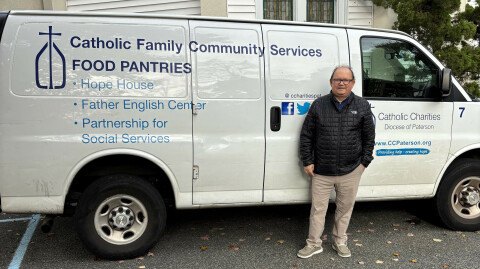TLDR: During the Feast of the Presentation, Luke 2:22-40, used the expressions, “According to the law of Moses… As it is written in the law of the Lord… According to what is stated in the law of the Lord… What was customary under the law… (and) Everything required by the law of the Lord.” These five expressions point to Jesus’ Jewishness. Read on for more.
The message the Gospel of Luke and Acts of the Apostles, the two books of Luke, want to give Theophilus (Luke 1:1-4) is that Jesus was a law-abiding, religious, righteous Judean from an equally law-abiding and righteous family. As such, Jesus posed no threat to the Judeans or the Romans, and neither do his disciples now, about fifty years after his death and resurrection. Luke 2:22-40, tells us the story of the young family fulfilling two different requirements of the law: Purification after forty days of the birth of a male child, and the Presentation or dedication to the Lord of that child, as required in Leviticus (For more about this, please see my sermon on our website https://saintdunstans.org/sermonvideos/.) Luke also gives us stories of Jesus and his disciples at various festivals, including Passover and Pentecost, to further build on the idea of Jesus as the good Judean. Below you will find a brief summary of the various Jewish festivals practiced during the time of Jesus, organized according to our Western calendar with the approximate dates when these festivals will fall in 2025.
I am concentrating primarily on religious holidays and not on the various civil holidays celebrated at the time of Jesus or by modern-day Jewish communities.
Purim: March 13-14
Purim celebrates the events narrated in the Book of Esther. A Jewish queen, aided by her cousin Mordechai, saves the nation of Israel from certain death at the hands of Haman, a wicked official of the Achaemenid Empire. A gullible and incompetent king, Ahasuerus, who appears quite weak, impulsive, and prone to extravagant acts to please his advisors, falls victim to the manipulations of his royal vizier, Haman. He signs an edict ordering the annihilation of the Jewish people across the 127 provinces of the empire. Queen Esther invites the King to two banquets to garner his favor and mercy, securing the safety of her people and revealing Haman’s wickedness. In an ironic twist, Haman is put to death in the same gallows he builds to kill his enemy, Mordechai. One of the features of the festival is the liberal use of alcohol. The Talmud, one of the Jewish commentaries, states that people should drink until they can't tell the difference between "Blessed be Mordechai" and "Cursed be Haman".
Pesach and Bar Matzot: April 12-20
Passover is based on Exodus 12:15-20, and many similar passages. The festival celebrates the rescue of the people of God from slavery in Egypt. It is one of the most holy festivals of the Jewish people, which recounts the episode of the ten plagues sent by God to Egypt to force them to let his people go free. These plagues ended with the killing of the first born of all Egyptian’s families and animals. But the Angel of the Lord Passed Over (Hence the name, Passover) the homes of the Israelites, sparing the lives of the firstborn Judean children and animals.
Unleavened Bread begins the day after Pesach and lasts 7 days. This reminds people of the events of the Exodus and exit from Egypt, when the people had no time to leaven their bread as they had to escape quite suddenly. Jewish people abstain from all foods containing leaven to remember their exit from Egypt.
Bikkurim: April 27
Based on Leviticus 23:9-14, the festival remembers God’s command that Israel dedicate the first fruits of all harvests, animals, and the first male child to the Lord. The feast is to be celebrated on “the day after the Sabbath” following Passover, on the first day of the week. What this means is that First Fruits always occurred on a Sunday, a week after Passover. The first fruits offering, as well as the command to offer every firstborn male and animal to the Lord, indicates that what is first and best belongs to God. This feast of Presentation is one of the two “requirements of the law” we celebrated this last Sunday. The baby Jesus was presented at the temple and was consecrated to the service of God.
Shavuot: June 1-3
This feast is based on Exodus 34:22, Leviticus 23:15-16, and the book of Ruth. Before Pentecost was a Christian celebration, it was a Jewish harvest festival, which always took place 50 days after Passover (Hence the name Penta = fifty.) The Jewish festival recalls the events at Mount Horeb when Moses received the Law (ten commandments) from God. It is customary during this feast to read the Book of Ruth, and to spend all-night studying the Torah (the law). A wide assortment of sweets, coffee, and other foods facilitate the all-night vigil of study and meditation on the Law of the Lord.
Rosh Hashanah and Yom Kippur: September 22-24 through October 2
Based on Leviticus 16 and 23:23-25, the “Head of the Year” festival marks the beginning of the Jewish calendar (Jewish New Year.) The feast is also called the Feast of Trumpets. The end of this festivity marks the beginning of a 10-day period of repentance and prayer which ends on Yom Kippur or the Day of Atonement (October 2). Yom Kippur is the holiest day of the Jewish calendar, marking the end of the 10 days of repentance. It is spent in fasting and fervent prayer. Sounding the shofar signals the holiday’s end. Whereas New Year’s celebrations in the West are characterized by partying, drinking, dancing, and other festivities, the Jewish New Year is marked by penance, introspection, and prayer.
Sukkot: October 6-13
Based on Leviticus 23:34-44 and Deuteronomy 16:13, the harvest festival of Booths or Tents is named for the temporary dwellings, called Sukkot, which the people of God used during their wanderings in the wilderness when they left Egypt. The holiday is marked by processions with palm branches. In some settings, tents are erected and decorated with fruits and vegetables to remember these ancient dwellings. Families are often joined by neighbors in these temporary dwellings to eat elaborate meals. The idea of extending hospitality to guests is central to Sukkot. The festival lasts seven days, with different guests joining families each day.
Chanukah/Hanukkah: December 14-22
Based on events narrated in the apocryphal books of Maccabees, the festival of Dedication celebrates the successful battle against the occupying Syrian Greeks 167-164 BCE. After the desecration of the Temple by empire forces, the Maccabees led a band of Jews in a successful battle against them. After successfully defeating their enemies, the nation was an independent state for over 100 years. One of the stories of the festival recounts the days after final victory, when the Temple was about to be cleansed and reconsecrated. The Maccabees wanted to light the Menorah in gratitude for the victory granted to them by God. Sadly, all they had was enough oil for one day. Miraculously, one day’s supply of oil lasted eight days, until more could be found. The Chanukah menorah is lit for eight nights to celebrate that miracle. Among the many Hanukkah traditions are the playing with dreidel, the lighting of one of the eight candles of the Menorah each day, and the eating of rich fried foods.
Christians, like Judeans, are memory people. We celebrate the great movements of our faith in similar ways. The Judeans celebrated their special relationship with God through these festivals and Jesus grew up celebrating them. We, who seek to know him more deeply, must be familiar with his Jewishness and must give thanks for the many ways in which that tradition formed him into the man he grew up to be.
May Christ continue to bless you,
Fr. Roman+





